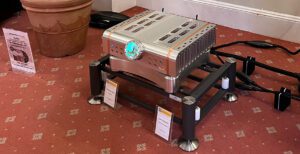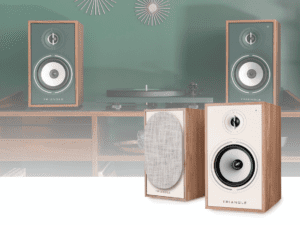
OK, there is an elephant in the room when it comes to audio amplification this year – Naim Audio. By upping the ante by an order of magnitude, to make its Statement NAC S1 preamp and NAP S1 mono power amplifiers, by building them big (263.5kg/581lb all up), by building them powerful (one horsepower per channel, capable of reputedly 9kW peaks) and by building them with a price tag in excess of $200,000, it was the talking point of the show. I wore down a camera battery or two showing people in other rooms this picture:
Just because the “What The F…” comments that hit home afterward were so entertaining. The raw specs don’t really do the Statement justice (when do they ever?), but some of the interesting factoids surrounding this freestanding BBQ-sized amplifier bear some repeating – Aluminium Nitride transistors, all sited on individual ‘nano’ diamond thermal conductors (as used in low earth orbit satellites). 4kVA transformers, a mass loaded vertical suspension system that looks like steampunk-meets-sci-fi, a stepped attenuator volume control that moves in and out of the circuit in milliseconds, just leaving the volume setting behind.

No one really knows whether this was designed to showcase Focal’s Utopia Grande EM loudspeakers (as the gossip suggested) or just to prove what Naim is capable of when the breaks are taken off (designer Steve Sells has been squirrelling away at this design since forever, apparently… he just didn’t think anyone would go this ape crazy enough to actually build the thing), but the myths behind the Statement almost add to the amp’s cachet, and the reputed 20+ pre-orders for an amplifier that costs almost as much as a new Cessna, show that there really is perhaps no upper limit to the buying power of the modern audiophile.
The interesting thing was this wasn’t the only $200,000 amplifier launch. Constellation Audio released the Hercules II Mono power amplifiers, at a healthy $90,000 per channel. Moving to a more conventional form factor from its predecessor, the new Hercules II Mono delivers 1.1kW up to 100kHz, but the amps are more than just about power. Constellation Audio was one of the first brands to reach this über-high-end market with its Reference series, and – while it now has a Performance range and more to follow, it hasn’t abandoned it’s top-notch roots.
Also, Kondo from Japan also launched the mighty Kagura mono power amplifiers. To prove just how much power they deliver, Kondo was playing the beast amplifiers into B&W 801D loudspeakers – a loudspeaker that demands heavy driving. This massive 211-based single-ended triode 55W monoblock has been seen before at shows, but in prototype form, and with no fixed price tag. Now it is finished and has a price tag, and it’s stuffed full of zeros!
Let’s put this into perspective. Having been exposed to repeated doses of ionizing $200,000+ price tags in relatively quick succession, I was feeling a little dazed. Near to one of these ‘radiological’ price tags was Dan D’Agostino Audio’s room. First, I heard the words “You think that’s bad? My wife spends more than that on handbags every year!” from a Chinese visitor in the room at the time. Then, I found myself thinking how much of a bargain a Momentum integrated amplifier sounds, when considered in terms of fractions of a handbag! The D’Agostino Momentum integrated ($45,000, Hermès crocodile-skin Birkin bag definitely not included) successfully combines the all-balanced Momentum preamp and 200W stereo power amplifier in ‘one’ chassis – in fact, the amplifier itself sits on a separate massive power supply that acts as the base, and two hefty hausers link the components together. The amp has a redesigned heatsink arrangement that still retains the amp’s Nemo-esque style, but keeps even cooler under pressure.
While we are skirting round the subject of super high-end prices, two of Switzerland’s top names in top-end audio both announced amplifier products this year. CH Precision launched its bridgeable 200W M1 mono power amplifier at the show. Expect a price somewhere between ‘much’ and ‘a lot’. Meanwhile, Soulution showed its new $65,000 dual-mono 711 stereo power amplifier, a switch mode, ultra-wide-bandwidth design that delivers 150W into eight ohms and ‘doubles down’ perfectly right to 600W into two ohms. One thing’s clear; apart from penknives and alp-shaped chocolate, quality doesn’t come cheap in Switzerland.
Staying with Central European esoterica, German technologists T+A Elektroakustik marked its 35th birthday by bringing its 3000 HV range to the American market for the first time, adding a new $15,000 P 3000 HV preamplifier, A 3000 HV power amp ($37,000 per pair) and optional PS 3000 HV power supply for the power amps ($25,000 per pair). HV here stands for ‘High Voltage’ and the T+A flagship line is designed to run at the sort of voltages normally seen in tube amplifiers and uses fully discrete circuits, allowing the power amps to deliver 500W in stereo mode and a kilowatt in bridged mono mode.
There’s an odd inversion here. Traditionally, the Europeans tend toward making more minimalist, lower powered, cheaper and sometimes less extravagant audio amplifiers than our American counterparts, but this year, often the reverse was true. Take US high-end mainstay Krell, for example. The company’s new iBias system is an intelligent, constantly self-evaluating Class A circuit that allows the company to build amplifiers with all those traditional Krell values, but without the heat and energy consumption that are less well-suited to today’s environmentally-snuggly world. The intelligent bias circuit is so smart, it can warn the user or the supplier of impending problems with the amplifier, just like the HAL 9000 computer did in 2001 A Space Odyssey, only this time without the frozen scientist killing spree. A seven-strong launch, Krell announced four models in the two-channel power amp range – which range from $7,500 for the Duo 175 stereo chassis up to $11,250 for the Solo 575 (the numbers denoting power per channel in watts, naturally), and it’s logical to assume there will be preamps and processors to match.
On the subject of simultaneous multi-launches, Pass Labs only had one thing to show this year, but it showed it nine times in a row. Pass’ X-Series and XA-Series nine-strong power amplifier range moved up to ‘point 8’ status this year, Each model has undergone fairly significant changes, including improved voltage gain and input blocks, larger power supplies, better filtration, and more, higher power MOSFETs in the output stages. Prices range from £6,400 for the X150.8 stereo chassis up to $40,000/pr for the XA200.8 Class A monoblocks.
Ayre is also updating its top amplifier range, but also offers existing customers the chance to upgrade their current models. Having learned a significant amount in developing its latest 5-series amplifiers, the company has turned its attention to the popular KX-R preamp and MX-R monoblocks, with the VX-R to follow later. The new ‘Twenty’ version of the KX-R (to celebrate the brand’s 20th year) features increased capacitance in the power supply, improved gain stages and the use of the new/old ‘Diamond’ output stage. Even less is retained of the older circuit in the MX-R in the update, and the new circuit sports the company’s ‘Double Diamond’ layout. Anglophile audiophiles with fairly long memories may remember the advertising campaign for Double Diamond India Pale Ale – “Double Diamond Works Wonders” – we shall see…
Where Ayre has taken its latest pre-power design cues from its integrated, Constellation Audio has worked in the other direction. Shown – but not played – at the HFN Show just outside of London, the new Constellation Audio’s new $20,000 Argo integrated amplifier from its Performance line pulls together elements of the Virgo preamplifier and Centaur power amps to create a 125W integrated more than able to partner Magico’s S5s. An Inspiration Line that lowers the price of Constellation Audio admission to just interplanetary levels is planned, too.
Moving over from solid to hollow state, VTL showed two revised products at the CES event; the $33,500 S400 Series II tower of power had been seen before at RMAF, but the $13,500 TL-6.5 Series II Signature line preamp is new to the show. It features an improved power supply, a redesigned current gain stage and better quality capacitors. The two combined were an obvious match with Wilson Alexias.
Staying with tubes, VAC pushed the boundaries of everything once more. The idea of Focal Utopia Grande EM being driven by tube amplification is absurd to many on the other side of the pond. I don’t think anyone had told VAC, because it went ahead and drove them. Admittedly it took the company’s $116,000 self-biasing Statement 450iQ monoblocks, fed by the $66,000 Statement Line preamp and $70,000 Statement Phono preamplifier, but drive them they most certainly did.
Moving back to solid-state Boulder has finally waved a fond farewell to its 2000 series amplifiers, replacing it with its 2100 series. The Boulder 2110 preamp in particular is a tour-de-force, a $54,000 mainframe with pull-out modules and the kind of power supply that most big power amps would be proud of. It’s joined by a stereo and mono power amplifier that effectively define ‘solid’ build. Boulder’s top-of-the-Venetian room was almost back to front, however, with the show and tell part front and centre, and the listening room consigned to a too-small room in the corner. Nevertheless, when it comes to sheer muscle power, this is more powerful than most.
Not demonstrating, but very much on show, Simaudio’s Moon launched three products at CES. The first, the 260D is a CD transport in the Neo series ($2,000 CD only, $3,000 CD and DAC) was interesting in its own right, but the company also announced two slim units from the Evolution Series; the 820S power supply ($8,000) and the 760A 130W stereo power amp (also $8,000). The PSU is designed to aid performance in the 740P preamp, 650D and 750D DAC/CD transports and the 610LP and 810LP phono stages. Meanwhile, the 760A is a no-feedback design with balanced and single ended inputs and bipolar output stages. It’s designed to provide a bridge between Neo and Evolution power amp lines.
Finally, one of the more real-world brands at the show, Arcam demonstrated the first of its new ‘64’ platform, the $5,000 A64. Built on a chassis normally reserved for home theatre amps for the brand, Arcam’s new Class G circuit means the 200W per channel amplifier is capable of delivering 50W in Class A, yet goes super green in sleep mode with just 0.5W power consumption and is said to go so loud, the company was considering putting a dial that goes up to 11. Like the popular A19, it includes power supplies for the rSeries products (Arcam doesn’t like onboard DACs) and is supplied with a MM phono stage that can be switched out for more line inputs. This marks the start of Arcam’s new ‘designed in the UK, built in Canada’ venture.
Tags: FEATURED
By Alan Sircom
More articles from this authorRead Next From Blog
See all
Audio Show Deluxe 2024: A photo show report
- Mar 28, 2024

Paul Messenger 1949-2024: A personal tribute
- Mar 26, 2024

Bristol Hi-Fi Show 2024: See You There!
- Feb 21, 2024

Triangle Borea Connect
- Feb 19, 2024






















